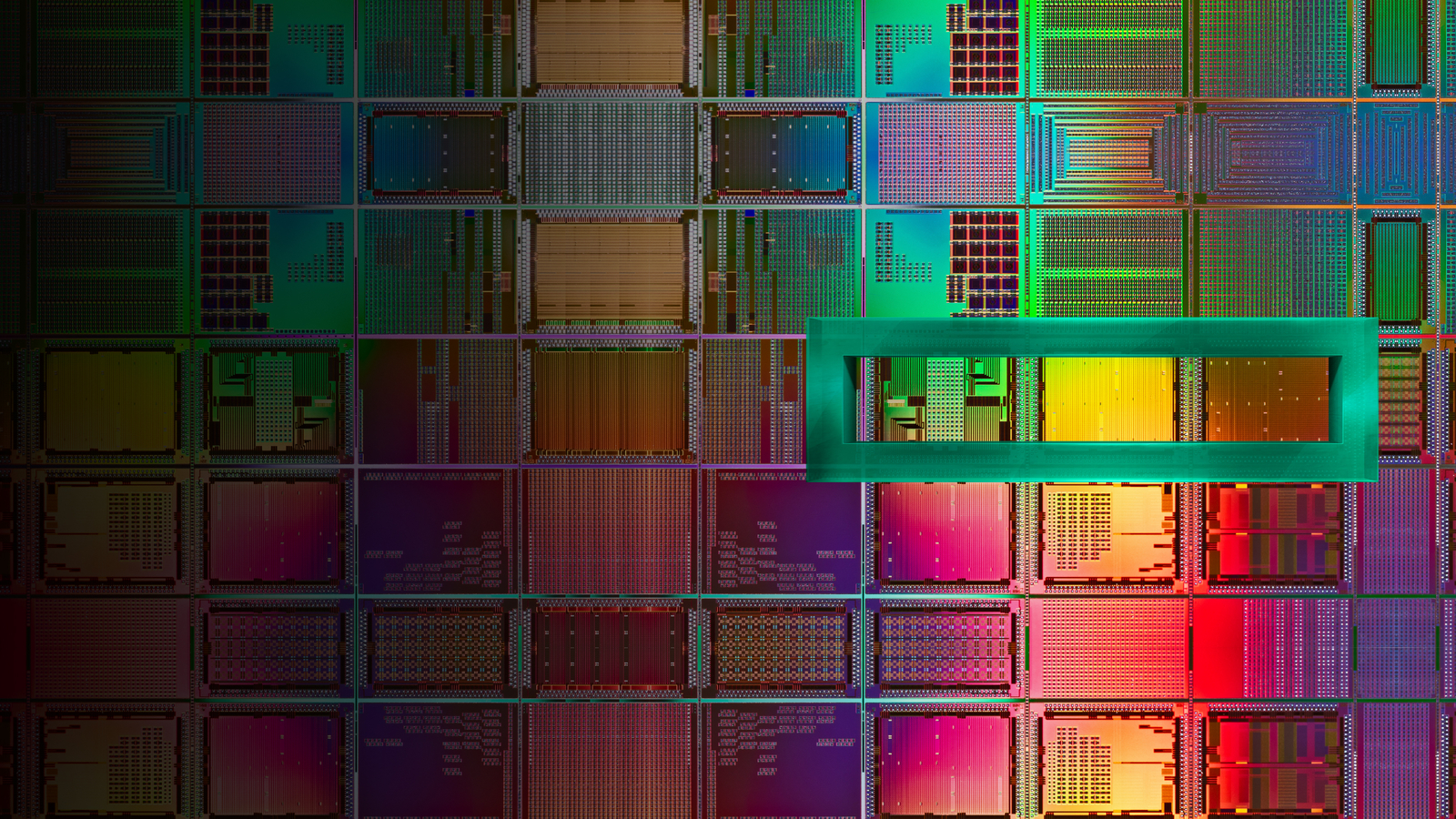A real-life example illustrates the concept and necessary settings for split valuation based on the origin of the product.
Key Concept
Split valuation is a function in SAP R/3 and mySAP ERP Central Component that allows you to value stock for a product based on different attributes – for example, the origin of the product or whether or not the product is produced in-house or procured externally. This method provides more accurate information for the actual value of particular stock. It requires that you have the Materials Management (MM) and FI modules implemented.
Split valuation is important to management accountants as it assists in understanding the true value and costs of stock holdings. SAP R/3 and mySAP ERP Central Component (ECC) use valuation types to allow for split valuation. A valuation type is an extension of the material master, adding another level to the material master data.
Figure 1 shows the three data levels. Initial creation of the material master is on the client level, which allows all plants in the system to use this material, thereby avoiding multiple identical materials for the plants. The second step is to create the material on plant level, assigning more specific data, such as profit center, valuation class, and sales organization, which distinguishes the material per plant. When using split valuation, you create an additional level using the valuation type. This provides the ability to recognize stock within a plant based on certain characteristics.

Figure 1
Available levels for maintaining data in the material master
I’ll provide an example of the use of split valuation to determine tax benefits when a product is manufactured in two different countries.
Offset Costs with Split Valuation
A company does research and development in country B. However, the production of a developed product is done in country A in a separate legal entity of the same company. To allow for maximum tax benefits, the company wants the profit for the products to be in country B, as it can be offset against the costs for R&D in that country.
To do this, the company has its country A division sell the products to that of country B at production cost price, making the country B division the owner of the stock. The country B division does quality control and marks up the sales price to include coverage for R&D and profit. It then sells the goods to, among others, the country A division.
The problem here, when using single valuation, is for the country A unit to distinguish the two types of stock for the same material, first because R/3 does not allow for more then one price per material per plant and second because it would be hard to identify the stock produced versus stock purchased.
The production cost for product Z is as follows, taken from master data for country A.
The master recipe calls for 100 kg of product Z. (Master recipe is a term used by the Production Planning for Process Industries [PP-PI]. The equivalent terms in R/3 Production Planning (PP) are routing and bill of material.) The following costs do not include any of the costs associated with the R&D to develop the product:
- 100 raw materials at $4: $400
- 10 hours at $60 an hour: $600
- Standard price: $1,000
Country A’s division produces product Z and receipts it into stock using the valuation area PROD (for produced):
- Quantity: 100 kg
- Value: $1,000
- Valuation type: PROD
The product is then sold to the country B division at that price. Country A issues the product and country B receipts it. For my example, country A now sells 50 kg to country B leaving it with 50 kg of produced stock. Intra-company sales of 50 kg from country A to country B leads to an issue of stock to company A as follows:
- Quantity: 50 kg
- Value: $500
- Valuation type: PROD
The receipt into stock country B amounts to the following:
- Quantity: 50 kg
- Value: $500
- Valuation type: N/A
The country B division does quality control and finds the product is OK. It then sells the product back to country A for a price that is marked up to cover R&D and a profit. Country B determines the sales value of product Z at $30 per kg for the intra-company sales of 50 kg from country A to country B. The issue of stock to country B is:
- Quantity: 50 kg
- Value: $500
- Valuation type: N/A
The receipt into stock for country A using the valuation area PURC (for procured) is:
- Quantity: 50 kg
- Value: $1,500
- Valuation type: PURC
By doing this the profit for the product falls in country B. Country A receives the semi-finished product again but now against the higher value and different valuation type. It can either sell it or use it at the higher value in a finished product.
As country A only sold 50 of the produced 100 kg, it now has 50 kg of produced and 50 kg of procured stock at different prices. If the company had used single valuation, the only information available would have been:
- Quantity: 100 kg
- Value: $20
- Stock value: $2,000
However, because the company used split valuation, the actual value of the batches is also available. The stock value in country A on valuation type level is:
Quantity: 100 kgValue: $2,000- 50 kg @ $10 (PROD)
- 50 kg @ $30 (PURC)
Customizing Settings and Master Data Prerequisites
To allow creation of the valuation types, use transaction code MM01 at the initial creation of the material on the plant level. Check the Valuation Category check box on the accounting 1 view shown in Figure 2.
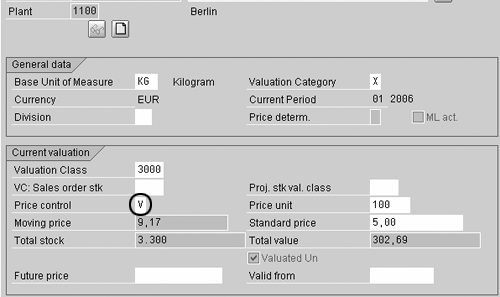
Figure 2
Only Price control V (moving average price) is allowed on the plant level
Split valuation can only use price control V (moving average price) at the plant level of the material master for a specific product. This is because, at plant level, the price is calculated as an average of the prices at valuation type level. Figure 2 shows the price at the plant level.
After the initial creation of the material with a valuation category, you can extend the valuation area level for the material with one or more valuation types. You can then use these valuation types to valuate stock within the same plant differently. As it is an extension of the material, the valuation class can be different for every valuation type.
The valuation class determines the accounts to which the system posts the value. Therefore, you have the option to post price differences to different accounts based on their nature. For example, the procured stock price differences go to a purchase price difference account while the produced stock is posted to a production variance account. Figure 3 shows stock at the valuation level.
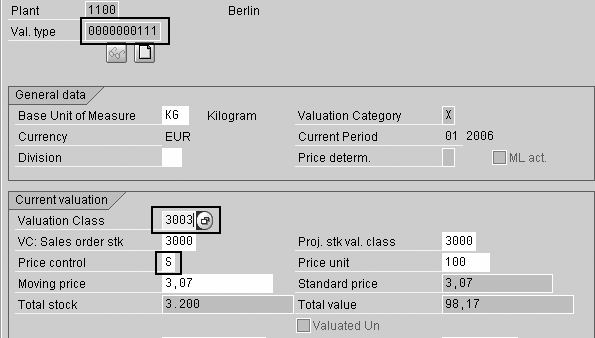
Figure 3
Valuation level with valuation type
At the valuation level, the valuation type is shown below the Plant field. You can set the price control to either moving average or standard and create distinct valuation classes for each of the valuation types. The only requirements to activate split valuation are to maintain and activate:
- Split valuation
- Activate split valuation categories
- Activate the categories for a plant
You activate split valuation via transaction OMW0 (Figure 4).

Figure 4
Activate split material valuation by checking the Split material valuation active button
Figure 5 shows the first screen of the customizing for split valuation.

Figure 5
Buttons in the transaction to allow you to navigate to different parts of the customizing
Click on the Global categories button to get to the screen shown in Figure 6, where you define the valuation categories.
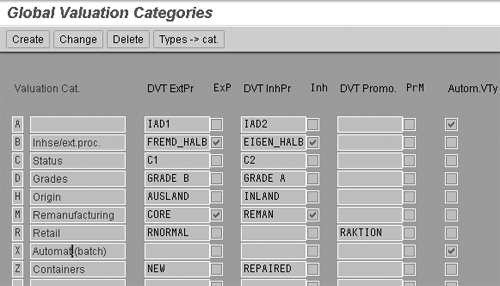
Figure 6
Valuation categories available in the system. You can configure more if you need them
R/3 and ECC deliver a range of standard valuation categories, as shown in Figure 6, that you can use after activating them for the plant:
Automatic VTyp stands for automatic valuation type. When you check this box, the system automatically creates a valuation type for every goods receipt with a new batch of the product. Automatic Vtyp is checked for categories A and X. Therefore, a new valuation type is created automatically every time a new batch is created/received. You can create three valuation types for the other categories by typing the names in the relevant boxes in Figure 6. You need to maintain these categories when using split valuation and before you create the materials using MM01 for split valuation purposes.
Click on the Local definitions button shown in Figure 5 to activate the split valuation categories you want to be able to use for the individual plants. Figure 7 shows the activation of valuation categories. Even though nine different valuation categories are available in the system, you can use just the ones that you have activated in the Status column for the plant you maintain.
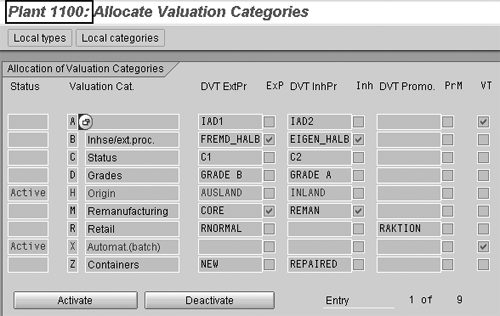
Figure 7
Only categories with the Active designation can be used in the plant
In my example, using split valuation, profits then can be taken in country B for stock purchased at $10 and sold at $30 per kg, leaving it with a $20 profit per kg. Country A can still distinguish the stock produced under valuation type PROD at $10 per kg and the stock procured under valuation type PROC at $30 per kg.
Besides this example, many other reasons exist for considering split valuation as the basis for stock valuation. It is a relatively easy way to obtain more information from the stock system, providing you with much more detail – for example, on trends in cost prices or the differences between vendors.
Mark van Hoving
Mark van Hoving is a FI/CO consultant with Oxygen Business Solutions, a specialist SAP consulting firm. Mark has been working with SAP since 1998, focusing on the FI/CO modules with emphasis on Product Costing, Cost Center Accounting, CO-PA, and cross-module integration to FI/CO. He also has experience with PP, MM, ABAP, and BW.
You may contact the author at mark.vanhoving@oxygenforbusiness.com.
If you have comments about this article or publication, or would like to submit an article idea, please contact the editor.









